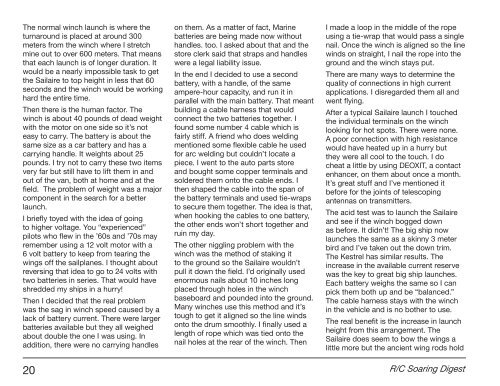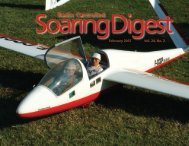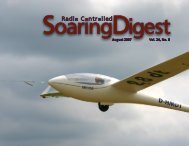Sep - RCSoaring.com
Sep - RCSoaring.com
Sep - RCSoaring.com
You also want an ePaper? Increase the reach of your titles
YUMPU automatically turns print PDFs into web optimized ePapers that Google loves.
The normal winch launch is where the<br />
turnaround is placed at around 300<br />
meters from the winch where I stretch<br />
mine out to over 600 meters. That means<br />
that each launch is of longer duration. It<br />
would be a nearly impossible task to get<br />
the Sailaire to top height in less that 60<br />
seconds and the winch would be working<br />
hard the entire time.<br />
Then there is the human factor. The<br />
winch is about 40 pounds of dead weight<br />
with the motor on one side so it’s not<br />
easy to carry. The battery is about the<br />
same size as a car battery and has a<br />
carrying handle. It weights about 25<br />
pounds. I try not to carry these two items<br />
very far but still have to lift them in and<br />
out of the van, both at home and at the<br />
field. The problem of weight was a major<br />
<strong>com</strong>ponent in the search for a better<br />
launch.<br />
I briefly toyed with the idea of going<br />
to higher voltage. You “experienced”<br />
pilots who flew in the ’60s and ’70s may<br />
remember using a 12 volt motor with a<br />
6 volt battery to keep from tearing the<br />
wings off the sailplanes. I thought about<br />
reversing that idea to go to 24 volts with<br />
two batteries in series. That would have<br />
shredded my ships in a hurry!<br />
Then I decided that the real problem<br />
was the sag in winch speed caused by a<br />
lack of battery current. There were larger<br />
batteries available but they all weighed<br />
about double the one I was using. In<br />
addition, there were no carrying handles<br />
on them. As a matter of fact, Marine<br />
batteries are being made now without<br />
handles. too. I asked about that and the<br />
store clerk said that straps and handles<br />
were a legal liability issue.<br />
In the end I decided to use a second<br />
battery, with a handle, of the same<br />
ampere-hour capacity, and run it in<br />
parallel with the main battery. That meant<br />
building a cable harness that would<br />
connect the two batteries together. I<br />
found some number 4 cable which is<br />
fairly stiff. A friend who does welding<br />
mentioned some flexible cable he used<br />
for arc welding but couldn’t locate a<br />
piece. I went to the auto parts store<br />
and bought some copper terminals and<br />
soldered them onto the cable ends. I<br />
then shaped the cable into the span of<br />
the battery terminals and used tie-wraps<br />
to secure them together. The idea is that,<br />
when hooking the cables to one battery,<br />
the other ends won’t short together and<br />
ruin my day.<br />
The other niggling problem with the<br />
winch was the method of staking it<br />
to the ground so the Sailaire wouldn’t<br />
pull it down the field. I’d originally used<br />
enormous nails about 10 inches long<br />
placed through holes in the winch<br />
baseboard and pounded into the ground.<br />
Many winches use this method and it’s<br />
tough to get it aligned so the line winds<br />
onto the drum smoothly. I finally used a<br />
length of rope which was tied onto the<br />
nail holes at the rear of the winch. Then<br />
I made a loop in the middle of the rope<br />
using a tie-wrap that would pass a single<br />
nail. Once the winch is aligned so the line<br />
winds on straight, I nail the rope into the<br />
ground and the winch stays put.<br />
There are many ways to determine the<br />
quality of connections in high current<br />
applications. I disregarded them all and<br />
went flying.<br />
After a typical Sailaire launch I touched<br />
the individual terminals on the winch<br />
looking for hot spots. There were none.<br />
A poor connection with high resistance<br />
would have heated up in a hurry but<br />
they were all cool to the touch. I do<br />
cheat a little by using DEOXIT, a contact<br />
enhancer, on them about once a month.<br />
It’s great stuff and I’ve mentioned it<br />
before for the joints of telescoping<br />
antennas on transmitters.<br />
The acid test was to launch the Sailaire<br />
and see if the winch bogged down<br />
as before. It didn’t! The big ship now<br />
launches the same as a skinny 3 meter<br />
bird and I’ve taken out the down trim.<br />
The Kestrel has similar results. The<br />
increase in the available current reserve<br />
was the key to great big ship launches.<br />
Each battery weighs the same so I can<br />
pick them both up and be “balanced.”<br />
The cable harness stays with the winch<br />
in the vehicle and is no bother to use.<br />
The real benefit is the increase in launch<br />
height from this arrangement. The<br />
Sailaire does seem to bow the wings a<br />
little more but the ancient wing rods hold<br />
20 R/C Soaring Digest
















